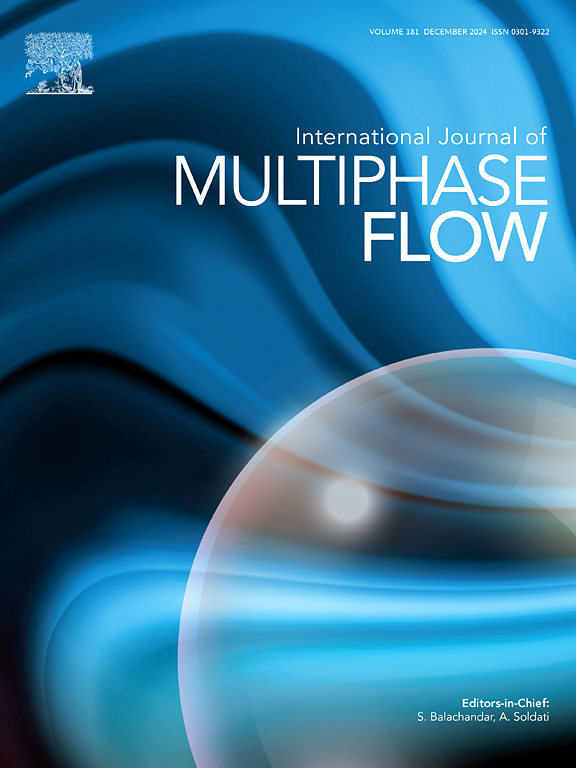用于颗粒流浓度测量的毫米波干涉仪的验证和校准
IF 3.6
2区 工程技术
Q1 MECHANICS
International Journal of Multiphase Flow
Pub Date : 2025-04-15
DOI:10.1016/j.ijmultiphaseflow.2025.105234
引用次数: 0
摘要
毫米波干涉测量法是一种测量不透明分散多相流中绝对浓度的新方法。它的优点包括:与光学辐射(即近可见光)相比,能够以最小的传输损耗穿透致密颗粒云;对体积分数的线性响应与颗粒特性基本无关;使用安全的非电离辐射;千赫兹采样率;以及结构紧凑、成本低廉的硬件。当需要亚波长分辨率时,空间分辨率是该技术的主要限制因素。在这项工作中,我们比较了两种校准毫米波雷达干涉仪以进行绝对浓度测量的方法:一种是使用已知颗粒浓度的直接方法,另一种是依靠测量散装颗粒样本相对介电常数的间接方法。通过使用高分辨率 X 射线微观层析成像技术来测量颗粒大小分布,并采用容许重叠的颗粒计数算法,改进了作者早期工作中得出的直接校准结果。间接校准方法利用定制的基于干涉的技术来测量毫米波频率下块状粉末的相对介电常数。在使用 Lichtenecker 对数有效介质方程时,两种校准方法的结果一致性在 0.7% 以内。两种独立校准程序之间的一致性验证了毫米波干涉测量法的理论框架。本文章由计算机程序翻译,如有差异,请以英文原文为准。

Validation and calibration of a millimeter-wave interferometer for concentration measurements in particle-laden flows
Millimeter-wave interferometry is a novel method for measuring absolute concentrations in opaque dispersed multiphase flows. Its advantages include: the ability to penetrate dense particles clouds with minimal transmission loss compared to optical radiation (i.e., near-visible light), a linear response to volume fraction that is mostly independent of particle properties, the use of safe non-ionizing radiation, kilohertz sampling rates, and compact low-cost hardware. Spatial resolution is the main limiting factor of the technique when sub-wavelength resolution is required. In this work, we compare two methods to calibrate a millimeter-wave radar interferometer for absolute concentration measurements: a direct method that uses known particle concentrations, and an indirect method that relies on measuring the relative permittivity of bulk particle samples. Direct calibration results derived from earlier work by the authors are improved through the use of high-resolution X-ray micro-tomography to measure the particle size distribution and overlap-tolerant particle counting algorithms. The indirect calibration method utilizes a custom interference-based technique to measure the relative permittivity of a bulk powder at millimeter-wave frequencies. Results from both calibration methods agree within 0.7% when using the Lichtenecker logarithmic effective medium equation. The agreement between the two independent calibration procedures validates the theoretical framework of millimeter-wave interferometry.
求助全文
通过发布文献求助,成功后即可免费获取论文全文。
去求助
来源期刊
CiteScore
7.30
自引率
10.50%
发文量
244
审稿时长
4 months
期刊介绍:
The International Journal of Multiphase Flow publishes analytical, numerical and experimental articles of lasting interest. The scope of the journal includes all aspects of mass, momentum and energy exchange phenomena among different phases such as occur in disperse flows, gas–liquid and liquid–liquid flows, flows in porous media, boiling, granular flows and others.
The journal publishes full papers, brief communications and conference announcements.

 求助内容:
求助内容: 应助结果提醒方式:
应助结果提醒方式:


